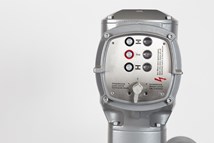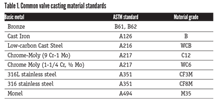Keeping an Eye on Valves and More: Fluor’s Ron Merrick
Ron Merrick, P.E., is one of those increasingly rare individuals: he has spent his entire professional career at one company.
Merrick is also a member of the Stainless Steel World America Steering Committee, a member of the Valve World Conference Members Steering Committee, and a presenter of papers on valve testing and standardization. He also is the author of Valve Selection and Specification Guide, published in 1991 by Von Nostrand Reinhold.
Merrick graduated from Wichita State University in December of 1974 with a degree in Mechanical Engineering. His job offer from Fluor in 1975 was for piping material takeoff, “which is literally sitting at a drawing board looking at isometrics and listing all the materials drawn,” he says. He took a stint at pipe stress, and then got into the material specifications (which was then called material engineering). It was a fairly new field at the time, but one that suited him.
A Special Interest in Standardization
Merrick is a strong believer in standardization, which he has a chance to practice not only through what he does at Fluor but in his extensive outside professional activities. In regards to his job, Fluor has as many as 200 projects going on around the world at any one time, and Merrick provides “the basis, the descriptions, the reference facts and so on” for the people involved, who then go on to customize this framework into their particular requirements. These reference facts include valve descriptions, piping and fitting descriptions, and the basic piping specs. Fluor does everything through automated piping material systems, he says, with the aim of having a single point of entry into the system: a description is written once, and whenever data is retrieved—be it a requisition, a picking ticket in the field or something else— “it all looks at that same piece of data,” he explains. The data resides physically at the company’s computer headquarters in Greenville, SC, but it’s accessible via a distributed network and maintained from Merrick’s location in Houston.
He carries over his appreciation of standards into his other activities: As vice-chair of the API downstream subcommittee, he’s charged with carrying out the subcommittee’s mission, which is to provide legislative/regulatory impact guidance and to develop standards for safety and environmental responsibility.
The subcommittee meets semiannually to go over the dozen or so standards for gate, check and ball valves, and related components. One reason is that as an ANSI-accredited body, API must reaffirm or reissue each standard every five years.
Merrick has been president of the PVF Roundtable since 1998. The roundtable gives its members—who are involved in various aspects of the valve and piping industry—a chance to meet and exchange ideas in the informal setting of General Assembly meetings, which are held several times a year.
Like API’s subcommittee, the organization also has occasion to set up task groups that involve standards consideration. For example, the group “did a lot of work that culminated in PMI [Positive Material Identification] standards,” Merrick explains. The group’s effort was the turned over to ASTM, which then issued ASTM-E1916.
Checking Up on Facilities
Merrick takes advantage of his extensive travel both here in the U.S. and abroad to visit nearby valve manufacturers located close to the meetings he attends. He also has been to China. In fact, he will be in Suzhou, China in September for the Valve World 2009 Conference and Expo. He says that, while Chinese plants may not be as neat and clean as those in the West, “there is up-to-date machinery and equipment, and a lot of investment in processes.” He uses these visits to “verify that a particular product ought to be suitable for use because I’ve seen it in the design and manufacturing stages and I know what’s in it,” reporting back to clients on what he finds, he says.
China is at the center of what Merrick considers a major trend in the valve industry over the past five years: Western companies partnering with Chinese companies, moving there or outsourcing to there. This has led the Chinese to put forth considerable time and effort to get their products up to Western quality standards, he says. He doesn’t discredit those who point out the very real problem of product counterfeiting, however. When it comes to Chinese products shipped to the U.S., he continues, he looks for products from Chinese facilities of Western companies because “they can provide their own ways of identifying product so we know it is genuine.”
Challenges and Opportunities
Asked about the biggest challenges facing valve users and the valve industry over the next few years, Merrick identifies standardization as well as the current business climate. However, he views standardization as more of an opportunity than a challenge for both individual countries and different industries. As examples he points to adoption of common standards by the Norwegian oil industry and a similar move by the German chemical industry. In the U.S., he points to the Process Industry Practices (PIP) organization. PIP publishes practices documents that harmonize engineering standards across different engineering disciplines (such as electrical, piping, process control and more), which can lead to significant cost savings, according to the organization. “What that does is give much more interchangeability and much more uniformity,” he says, as well as help in making sure that products from multiple manufacturers will work—and fit—together. This also helps to cut down on quality problems, he says.
What he does see as a very real challenge today is the reduction of capital expenditures. The huge wave of construction that occurred when times were good has been followed by a significant slowing of construction levels that should continue for the next few years with the result that “the demand for products in the U.S. may be slowing down a bit,” Merrick says.
As far as what’s ahead personally for Merrick, he says he doesn’t see himself retiring any time soon. What he has in mind instead “is gradually retrenching and spending more time doing just the parts of the business that [he likes], focusing on things that [he is] really good at and can make a contribution on, and more or less fading away.”
Peter Cleaveland is a contributing editor to Valve Magazine. Reach him at pcleaveland@earthlink.net.










 Unloading large gate valve.jpg;maxWidth=214)